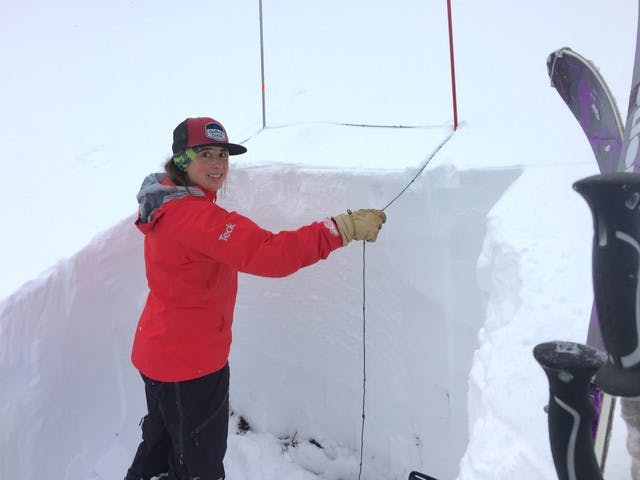- Date
- Sunday, December 23, 2018
Like a gift wrapped lump of coal
The holiday season conjures up images of tearing through layers of wrapping paper, cardboard boxes and packing material to reveal what’s inside. Exciting, right?
Let’s set the Christmas Holiday scene. Much of the mountainous regions in western Canada are experiencing a persistent slab problem. So it’s a persistent slab - what’s the big deal?

Image: Dec 15 Mountain Information Network post from Allen Creek of a size 2.5 persistent slab avalanche.
Why don’t we start out with a couple of definitions straight from Avalanche Canada’s online glossary:
- Persistent Slab - an avalanche problem that is defined by a slab formed over a persistent weak layer. New snow that accumulates and consolidates over a persistent weak layer is normally labeled a storm slab until the persistent nature of the weak layer becomes apparent over time.
- Persistent Weak Layer - A weak layer in the snowpack that resists forming a strong bond to neighbouring grains in the snowpack over an extended time period. Persistent weak layers are often composed of surface hoar or faceted snow.
Why the name persistent? It’s a problem in the snowpack that persists over a period of time. This is a complication, because we are generally impatient and want all of our problems to resolve themselves quickly. When it comes to persistent slabs, patience is a virtue. This point will become especially relevant in the coming days when you may start to see avalanche danger ratings decrease, yet the persistent slab problem will still be listed. The problem still exists, even though it’s less likely to trigger. Let your patience persist!
The problem with a persistent slab is that you can’t see it unless you peel back the layers of the snowpack to reveal the slab sitting on top of the persistent weak layer.

Image: Our South Rockies field team peeling back the layers of the snowpack to have look at what’s inside. If they are digging near Sparwood BC, there may actually be coal in the snow. Not kidding!
There is an additional complication that makes them even trickier to deal with; persistent weak layers don’t always form everywhere. So when they get buried, if you haven’t taken note of where the layer formed (or didn’t), it is difficult to ascertain where the problem may exist. You have to pointedly look for it or be told that it is there. It’s kind of like unwrapping a gift. You don’t know what’s inside until you tear through the layers of wrapping paper, cardboard and packing material...or somebody tells you what’s inside. In this instance what’s revealed is a big fat lump of coal. Get it? Persistent slab - gift wrapped lump of…

...anyhow
Digging and interpreting snowpack information is a learned skill that folks must hone over many years. On top of this, you have to dig a lot of holes to get a really good handle on where a persistent slabs exists and/or better yet, where they don’t. From a recreationists point of view, it may just be impractical to rely heavily on your snowpack interpretation skills and also to dig that many deep holes in the snow. Because of this, we can never be 100% certain about where the persistent slabs exist or not. For this reason, we need some wholly reliable tools to help us navigate uncertain situations.
The next section is taken from a blog we wrote last year on this very subject. We’ve copied and pasted it here because it offers some really good advice.
Managing persistent slabs
Persistent slabs are commonly associated with higher levels of uncertainty. This is because of the nature of where they form (which is often in patches such that one slope is infected but another isn't), when they become reactive and how reactive they are, how wide they propagate and how big an avalanche could potentially occur. This higher level of uncertainty should affect how we manage persistent slabs.
- Pull in the reigns. Adopt a conservative approach to choosing terrain. Be disciplined about maintaining that approach.
- Avoid steep, convex slopes.
- Stay away from thin/variable depth/rocky avalanche terrain.
- If the danger rating decreases, yet a persistent problem is still being reported in Avalanche Canada's forecasts, it means the problem remains. It only indicates the problem is less likely to trigger. This situation is almost harder to deal with because the temptation will be stronger than ever to step out and ride bigger terrain. The solution is to remember the first point above – Pull In The Reigns.
- When the sun comes out after a cool period, loose snow sluffs out of steep terrain and cornices can begin to fall. Small avalanches and cornice falls add significant weight to the slopes below and increase the chance of triggering deeper persistent weak layers. Take stock what is above you and minimize your exposure when the sun is out.
Although we labelled persistent slabs as gift wrapped lumps of coal (which is great analogy by the way), it’s not all bad news. Heed the advice above and be vigilant about it! It’s the only way to get some certainty from an inherently uncertain situation. Play it safe out there over the holidays and best of the season from all of us here at Avalanche Canada.